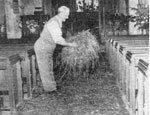Feast Sunday was also traditionally the day when rushes were strewn in the nave and aisles of the church.
Records of this interesting custom go back to 1798 when at the enclosure of the common lands of the Parish a small piece of land - the Church Piece, was given in exchange for land "left for the purpose of furnishing rushes for the church on Feast Sunday". We have no record of where the original land from which the rushes were obtained was. It is likely to be near the Thistlebrook since this land was often flooded.
From the 1830s if not earlier, hay was being used to strew the church rather than rushes and this is continued to this day.
The hay does not cover the all the aisles, nave and pews as it once did.
Click here to see a video clip of churchwardens strewing hay on June 30th 2001. Alternatively, for a speedier download - click here.
The custom was nearly extinguished in the late 19th Century but saved by the actions of the first parish councillors, particularly Mr Joseph Bonham - see the tale -Conflict in the Village
The custom is followed in other parts of the country - see Other Villages and may have a number of explanations:
Keeping the church floors clean - they were originally earthen and the patronal festival would be attended by lots of people who would have walked on muddy fields, roads and paths to reach the church for this important occasion. Rushes were commonly used in homes as carpets and the expression 'not worth a rush' meant that you were not worth changing the rushes in the guest room for'. E. Cobham Brewer 1810-1897. Dictionary of Phrase and Fable. 1898.
Keeping the church cool and fresh - rushes and hay would disguise the smells of large numbers of people congregated together. Also as bodies had been buried in the earthen floors there may have been other smells to overcome. The Herball to the Bible (1587) refers to "Sedges and rushes, the whiche manie in the countrie doe use in summer-time to strewe their parlors or churches, as well for coolness as for pleasant smell"
Wingrave has its own particular legend attached to the origin of the strewing.






